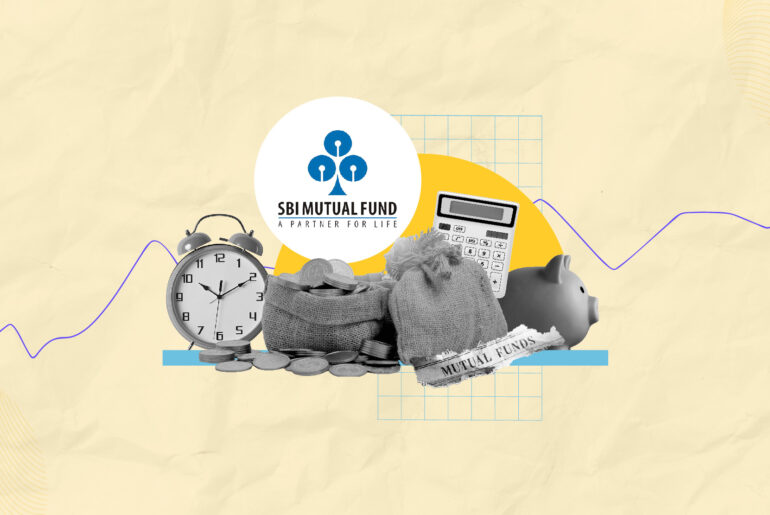Last Updated on May 25, 2022 by Neera Bhardwaj
A mutual fund is a type of investment option in which a pool of money, collected from a number of investors who share a common investment objective, is invested in assets with the goal of capital appreciation.
A mutual fund is managed by a professional fund manager who is tasked with asset allocation and performing risk management while attempting to maximize the gains from the investments. Each investor owns units of the fund which represent their portion of the holdings. Any income earned from the collective investment is distributed among the investors in proportion to the units or shares held by them. In this blog, we dive deep into what is a mutual fund and how it works.
Table of Contents
How do mutual funds work?
You can invest in a mutual fund in two ways. The first method is through a one-time lump sum investment. The second option is through a Systematic Investment Plan or SIP in which you invest in a mutual fund at fixed intervals, for example, monthly or quarterly.
A fund manager invests the pooled capital in various asset classes – generally equity and debt – depending upon the objective of the fund. The goal remains to provide the investors with capital appreciation. A benchmark index is made the basis for returns comparison and fund managers attempt to beat the market index to secure above-market returns in actively managed funds, and returns at par with the market in passively managed funds.
What investors get is units of the mutual fund scheme that can be traded in the stock market.
As the value of the securities that the fund invests in grows, the per-unit cost of the fund (Net Asset Value or NAV) grows in line. An investor makes a profit when the NAV they redeem the mutual fund units at is higher than the price they bought it for.
How to pick the right mutual fund?
While picking mutual funds, here are three important pointers for consideration:
- Pick a mutual fund that meets your short and long term financial objective.
- Pre-decide how much money you want to invest and for how long
- Consider the risks and volatility involved.
Making the right pick from the plethora of funds and fund schemes can seem daunting. There are various parameters that one may use to assess the suitability of a mutual fund to their portfolio. Some of them are as below:
- Historical returns
- Performance rating
- Performance against benchmark and peers
- Consistency in returns
- AUM size
- Cost of investment
How can an investor earn from a mutual fund?
Mutual funds create wealth in two ways. The first is through dividends. The second way is through capital gains. If the selling price of a security held by an investor is greater than the purchase price of the security, then the investor earns profit in the form of capital gains.
What is the Net Asset Value (NAV) of a mutual fund?
Investing in a mutual fund is not the same as buying a stock of a company. Unlike stock owners, mutual fund investors do not receive voting rights with the company. This is because your portion of a mutual fund represents an investment in many different securities instead of the holding of a company share.
The value of a mutual fund is denoted by its Net Asset Value or NAV. NAV is the market value of all the securities held by the mutual fund divided by the total number of units or shares of the fund. The NAV of a mutual fund does not fluctuate during market hours, rather it is settled at the end of each trading day, although the funds can be purchased and redeemed as needed.
NAV = (Value of all the assets – the expense of running the mutual fund)/number of units
Types of Mutual Funds
Equity Funds
Equity funds are the most common type of mutual funds. As the name implies, equity funds primarily invest in equity or stocks. There are various types of equity funds.
On the basis of the market capitalization of the companies invested in, equity funds can be divided into Large Cap funds (top 100 companies in terms of market capitalisation), Mid Cap funds (101st to 250th companies in terms of market capitalisation) and Small Cap funds (companies less than 250th in terms of market capitalisation). A Multi Cap fund invests in Large, Mid and Small Cap companies.
Equity funds can also be divided based on the growth prospects of invested stocks. Dividend funds invest primarily in dividend yielding stocks. Value funds invest in stocks that are undervalued and show potential for growth in the future. Contra funds invest in stocks that are not performing well – either over performing or underperforming – and have thus been shunned by other investors. The fund manager believes that over the long term, the price of these stocks will normalise and demand will increase.
In a focused fund, a fund manager invests in a few stocks (maximum 30) that they have carefully researched and that they believe will perform well. Sectoral or thematic funds invest in different types of companies in specific sectors of the economy like energy, healthcare, infrastructure etc.
ELSS funds are an equity-linked saving scheme with a statutory lock-in of 3 yrs and tax benefit of upto Rs 1.5 lakh under Section 80C of the Income Tax Act.
Debt funds
Debt funds are considered to be less risky than equity funds because they invest in securities with fixed incomes and maturity periods like government securities, corporate bonds, treasury bills and so on, and are not affected by fluctuations in the market. Although their risk is low, debt funds also usually offer less returns than equity funds. There are several types of debt funds too.
Liquid funds
Liquid funds are good for short term investments since they invest in instruments having a maturity of a maximum of 91 days. Similarly, money market funds invest in instruments with a maximum maturity of 1 yr. A dynamic bond fund invests in instruments across maturity periods depending on interest rates by altering portfolio allocations between short-term and long-term bonds.
Hybrid Funds
Hybrid funds are a combination of equity and debt funds and have different combinations of the two asset classes depending on the objective of the fund.
Index Funds
While most funds try to beat the market’s benchmarks and need to be actively managed, index funds simply track a market index and are thus, are passively managed. An index mutual fund will imitate a market benchmark like NSE Nifty or BSE Sensex and will not outperform or underperform it. It will just match its performance and return the earnings minus costs.
Advantages of investing in mutual funds
- Mutual funds provide a relatively safer avenue for investors who seek exposure to equities for higher returns but are wary of the risks or have no time or understanding of stock analysis.
- Being managed by a fund manager, mutual funds are a great way for individual investors to get access to professionally managed portfolios.
- Mutual funds provide investors with an opportunity to capture entire markets or market segments at a fraction of the cost.
- Mutual funds help investors diversify their portfolio through a single investment since mutual funds invest across different stocks or sectors or even across different types of securities depending on the type of the fund scheme.
- Mutual funds are easy to enter because, unlike the stock market which requires a great amount of time and analysis, the professional fund manager has already done the analysis.
- Mutual funds are liquid investments that can be redeemed and converted to cash quickly.
Disadvantages of mutual funds
- Mutual funds are subject to market risk and may experience volatility in the short term.
- The mutual fund manager is in charge of your fund and takes the decision on avenues for investment on your behalf.
- The cost of investment may be higher than in direct equity as there is an expense ratio – towards fund management – and some funds also levy an entry and exit load over and above the administration charges.
Mutual funds are great investment avenues that help you to diversify your portfolio through a single investment while also fetching you exposure to the stock markets. There are many types of mutual funds to suit the varying requirements of investors. Choose the right fund to invest in using the criteria mentioned in the article and do not forget to undertake risk profiling before investing in mutual funds.
- Hedge Funds in India: Types, Features, and Benefits - Apr 15, 2025
- SBI Equity Mutual Funds – List of Top Performing Schemes for 2025 - Mar 27, 2025
- List of Overnight Mutual Funds in India (2025) - Mar 17, 2025




